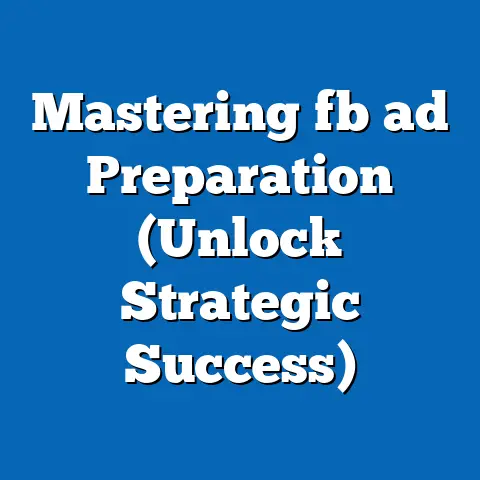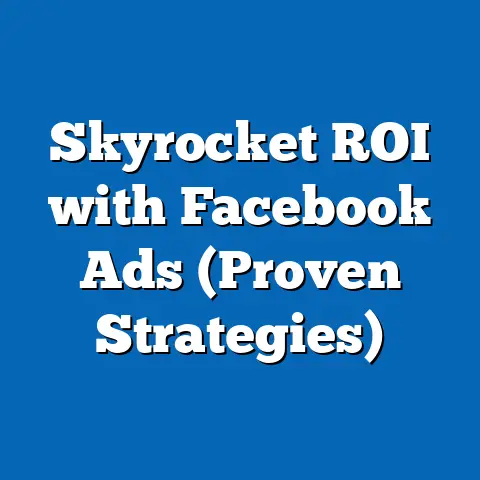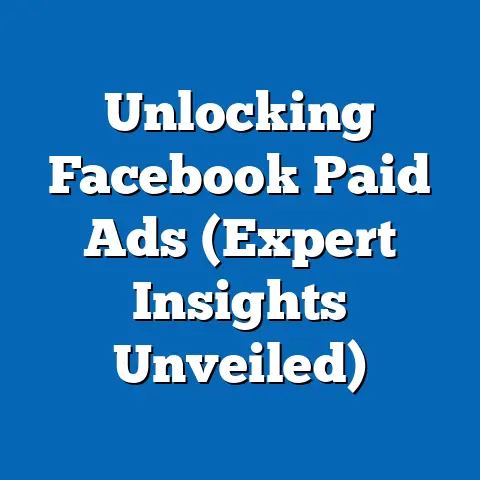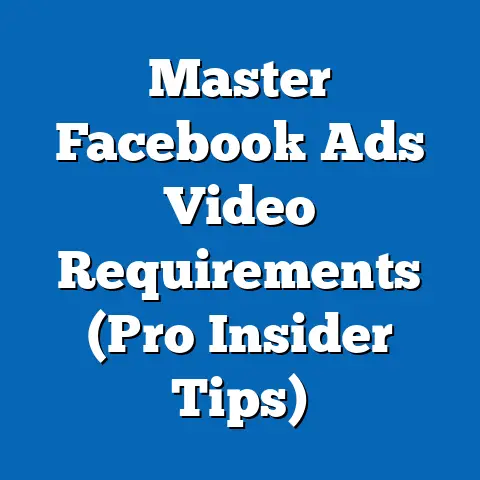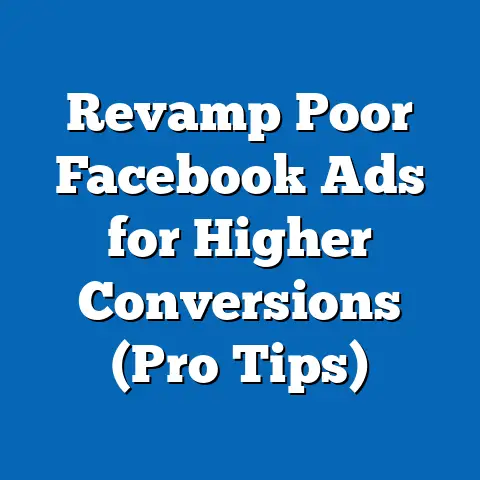Maximize Conceal Carry fb ad ROI (Cost-Saving Strategies)
Maximize Conceal Carry Facebook Ad ROI (Cost-Saving Strategies)
The world is changing, and with it, the landscape of personal safety. More and more individuals are recognizing the importance of responsible gun ownership and seeking concealed carry permits. Simultaneously, our society is becoming increasingly pet-centric. These two trends might seem unrelated at first glance, but they intersect in a significant way: responsible pet owners who prioritize personal and family safety.
This article isn’t just about selling holsters; it’s about connecting with this specific audience in a meaningful and cost-effective way. It’s about understanding their needs, respecting their values, and building trust through thoughtful and targeted Facebook advertising. And most importantly, it’s about maximizing your return on investment (ROI) while staying within budget.
We’ll explore strategies that not only improve your ROI but also ensure you’re reaching your ideal customer efficiently. We’ll delve into cost-saving techniques that allow your message to resonate with potential customers interested in conceal carry, particularly those who are also passionate about their pets. Let’s get started!
Understanding Your Target Audience
Before I even think about crafting an ad, I always start with a deep dive into understanding my audience. Who are they? What are their motivations? What are their concerns? In the conceal carry niche, and especially when targeting pet owners, this is crucial.
Demographics of the Pet-Owning Conceal Carry Enthusiast
While generalizations can be dangerous, some common demographic trends exist within this niche.
- Age: Typically, individuals aged 25-55 are more likely to own firearms and have conceal carry permits. This age range often coincides with family formation and increased awareness of personal safety.
- Gender: While historically male-dominated, the number of women seeking conceal carry permits is rapidly growing. This is a significant segment to consider.
- Location: Geographically, interest in conceal carry tends to be higher in states with less restrictive gun laws and in rural or suburban areas. However, urban areas are also seeing increased interest due to rising crime rates.
- Income: While not a strict determinant, individuals with disposable income are more likely to invest in firearms, training, and related accessories.
- Pet Ownership: Crucially, these individuals are pet owners! They likely identify as dog or cat lovers (or both!) and view their pets as members of their families.
Motivations of Pet Owners Interested in Conceal Carry
Understanding why someone wants to carry a concealed firearm is just as important as who they are. For pet owners, the motivations often extend beyond personal safety to include the well-being of their furry companions.
- Personal Safety: This is the primary motivator for most conceal carry permit holders. They want to be able to protect themselves and their loved ones from potential threats.
- Home Protection: The desire to safeguard their homes and families from intruders is a strong driver.
- Protection of Pets: This is where the pet owner angle comes in. They see their pets as vulnerable members of their family and want to be able to defend them in dangerous situations, whether it’s a home invasion, a dog attack during a walk, or a threat in public.
- Peace of Mind: Knowing they have the ability to protect themselves and their pets can provide a significant sense of security and peace of mind.
Audience Segmentation: Tailoring Your Message
Once you understand the general demographics and motivations, it’s time to segment your audience for more targeted advertising. Here are a few potential segments:
- New Pet Owners: Target individuals who have recently adopted a pet. They are likely more attuned to safety concerns related to their new family member.
- Dog Owners: Focus on dog owners, as they often walk their dogs in public areas, where they may be more vulnerable to threats.
- Female Gun Owners: As mentioned earlier, this is a growing segment. Tailor your messaging to address their specific needs and concerns.
- Rural Residents: Highlight the importance of self-reliance and protection in rural areas, where law enforcement response times may be longer.
Values and Concerns of Pet-Friendly Consumers
Pet owners are often highly conscious of ethical and responsible practices. When advertising to this group, it’s important to address their values and concerns.
- Safety: Emphasize the importance of responsible gun ownership and safe handling practices.
- Responsibility: Highlight the commitment required to own a firearm and the importance of proper training.
- Ethical Sourcing: If possible, promote products that are ethically sourced and made with sustainable materials.
- Animal Welfare: Support animal welfare organizations and promote responsible pet ownership practices.
Takeaway: Understanding your audience is the foundation of any successful advertising campaign. By taking the time to research their demographics, motivations, values, and concerns, you can craft more targeted and effective ads that resonate with their needs.
Crafting Effective Facebook Ads
Now that we’ve explored the intricacies of understanding your target audience, let’s get into the nitty-gritty of creating Facebook ads that capture their attention and drive conversions.
Key Components of a Successful Facebook Ad Campaign
A successful Facebook ad campaign is a symphony of elements working together in harmony. Here’s a breakdown of the essential components:
- Eye-Catching Visuals: In a sea of scrolling content, your ad needs to stand out. Use high-quality images or videos that are relevant to your target audience and visually appealing.
- Compelling Copy: Your ad copy should be concise, engaging, and persuasive. Clearly communicate the benefits of your product or service and address the needs and concerns of your target audience.
- Clear Call to Action (CTA): Tell people what you want them to do! Use a clear and concise CTA button, such as “Shop Now,” “Learn More,” or “Get a Quote.”
- Targeting Options: Facebook’s targeting options are incredibly powerful. Use them to reach the right people with the right message.
- Ad Placement: Experiment with different ad placements (e.g., Facebook News Feed, Instagram Feed, Messenger) to see what works best for your target audience.
Incorporating Pet-Friendly Themes into Ad Content
This is where we get to the heart of this niche. How do you weave the love of pets into your conceal carry advertising? Here are a few ideas:
- Show a responsible gun owner with their dog in a safe and controlled environment. This could be at a shooting range, on a hike in the woods, or simply relaxing at home.
- Highlight the peace of mind that conceal carry provides, knowing you can protect your pet in any situation.
- Use imagery of pets in your ads, even if they’re not directly related to the product being advertised. A subtle image of a dog or cat can help to grab the attention of pet owners.
- Offer a discount to pet owners who show proof of pet ownership. This is a great way to incentivize purchases and show that you value your target audience.
Example Messaging:
- “Protect yourself and your best friend. Get your conceal carry permit today!”
- “Your pet is family. Make sure you can protect them in any situation.”
- “Peace of mind for you and your furry companion.”
The Power of Storytelling
People connect with stories. Instead of just listing the features of your product, tell a story that resonates with your target audience.
- Share a case study of a pet owner who used their firearm to protect their pet from harm.
- Feature a testimonial from a satisfied customer who feels safer knowing they can protect their pet.
- Create a fictional scenario that highlights the importance of being prepared to defend yourself and your pet.
Example Story:
“Sarah was walking her dog, Max, in the park when they were approached by a stranger acting suspiciously. Sarah, a responsible gun owner with a conceal carry permit, was able to discreetly assess the situation and prepare to defend herself and Max if necessary. Thankfully, the stranger moved on without incident, but Sarah was grateful that she had the ability to protect herself and her beloved dog.”
High-Quality Images: The Foundation of Your Ad
Visuals are king (or queen) on Facebook. Make sure your images are:
- High-Resolution: Blurry or pixelated images are a turnoff.
- Relevant: The image should be directly related to your product or service.
- Appealing: The image should be visually appealing and capture the attention of your target audience.
- Safe and Positive: Especially when featuring firearms and pets, ensure the images depict safe handling practices and positive interactions.
Takeaway: Crafting effective Facebook ads is a blend of art and science. By understanding your audience, incorporating pet-friendly themes, telling compelling stories, and using high-quality visuals, you can create ads that capture attention, build trust, and drive conversions.
Budgeting and Cost-Saving Strategies
Now, let’s talk about the money. Running Facebook ads can be expensive, but with a strategic approach and a focus on cost-saving strategies, you can maximize your ROI without breaking the bank. I’ve personally seen campaigns succeed on surprisingly small budgets with the right tactics.
Breaking Down the Costs of Facebook Ads
Before you even launch your first campaign, it’s essential to understand the various costs involved.
- Ad Spend: This is the amount you pay Facebook for displaying your ads. You can set a daily or lifetime budget for each campaign.
- Creative Costs: This includes the cost of creating your ad visuals (e.g., photography, videography, graphic design) and writing your ad copy.
- Agency Fees (if applicable): If you’re working with a marketing agency, you’ll need to factor in their fees.
- Software Costs (if applicable): Some marketers use third-party software to manage their Facebook ad campaigns.
- Hidden Fees: These can include things like taxes and currency conversion fees.
Cost-Saving Strategies: Stretching Your Dollar
Here are some proven cost-saving strategies that I’ve used to maximize ROI on Facebook ad campaigns:
- Set a Realistic Ad Budget: Don’t overspend! Start with a small budget and gradually increase it as you see results.
- Use Facebook’s Ad Optimization Tools: Facebook offers a variety of ad optimization tools that can help you to lower your costs and improve your ROI. These include:
- Campaign Budget Optimization (CBO): This allows Facebook to automatically distribute your budget across your ad sets to maximize performance.
- Bid Strategies: Choose the right bid strategy based on your campaign goals (e.g., lowest cost, target cost, bid cap).
- Ad Scheduling: Run your ads only during the times when your target audience is most active.
- Focus on Organic Reach: Don’t rely solely on paid advertising. Create engaging content that will attract organic reach and build a loyal following.
- Retargeting Ads: This involves showing ads to users who have previously engaged with your content. Retargeting ads are typically more effective and less expensive than targeting cold audiences.
- Leverage User-Generated Content (UGC): Encourage your customers to create content featuring your products. UGC is authentic, engaging, and free!
- Partnerships with Influencers: Partner with influencers in the pet and firearms communities to promote your products to their followers. This can be a cost-effective way to reach a large and targeted audience.
- A/B Testing: Continuously test different ad creatives, targeting options, and bidding strategies to identify what works best for your target audience.
- Monitor Your Ad Performance Regularly: Keep a close eye on your ad performance metrics and make adjustments as needed.
- Campaign Budget Optimization (CBO): This allows Facebook to automatically distribute your budget across your ad sets to maximize performance.
- Bid Strategies: Choose the right bid strategy based on your campaign goals (e.g., lowest cost, target cost, bid cap).
- Ad Scheduling: Run your ads only during the times when your target audience is most active.
Retargeting: The Secret Weapon
Retargeting is one of the most powerful cost-saving strategies available to Facebook advertisers. It allows you to show ads to people who have already interacted with your brand, such as:
- Website Visitors: Show ads to people who have visited your website.
- Page Engagers: Show ads to people who have liked or followed your Facebook page.
- Video Viewers: Show ads to people who have watched your videos.
- Lead Form Submitters: Show ads to people who have submitted a lead form.
Because these users are already familiar with your brand, they are more likely to convert. Retargeting ads typically have a higher click-through rate (CTR) and conversion rate than ads targeted to cold audiences, which means you can achieve better results for a lower cost.
Leveraging User-Generated Content and Influencer Partnerships
UGC and influencer partnerships are two more cost-effective ways to amplify your reach and build trust with your target audience.
- User-Generated Content: Encourage your customers to share photos and videos of themselves using your products. You can then feature this content in your ads or on your social media channels. UGC is authentic, engaging, and free!
- Influencer Partnerships: Partner with influencers in the pet and firearms communities to promote your products to their followers. Choose influencers who have a genuine connection with your target audience and who align with your brand values.
Takeaway: Budgeting and cost-saving strategies are essential for maximizing your ROI on Facebook ad campaigns. By understanding the costs involved, using Facebook’s ad optimization tools, focusing on organic reach, retargeting ads, leveraging UGC and influencer partnerships, and monitoring your ad performance regularly, you can achieve better results for a lower cost.
Analyzing Ad Performance
You’ve launched your campaign, the ads are running, but the work doesn’t stop there! In fact, it’s just beginning. Analyzing your ad performance is crucial for understanding what’s working, what’s not, and how to optimize your campaigns for maximum ROI.
Key Performance Indicators (KPIs) for Facebook Ads
Here are some of the most important KPIs to track for your Facebook ad campaigns:
- Impressions: The number of times your ad was shown.
- Reach: The number of unique people who saw your ad.
- Click-Through Rate (CTR): The percentage of people who clicked on your ad after seeing it (Clicks / Impressions). A higher CTR indicates that your ad is relevant and engaging.
- Cost Per Click (CPC): The average cost you paid for each click on your ad (Ad Spend / Clicks). A lower CPC indicates that your ad is efficient.
- Conversion Rate: The percentage of people who completed a desired action (e.g., made a purchase, submitted a lead form) after clicking on your ad (Conversions / Clicks). A higher conversion rate indicates that your landing page is effective.
- Cost Per Conversion (CPC): The average cost you paid for each conversion (Ad Spend / Conversions). A lower CPC indicates that your campaign is efficient.
- Return on Ad Spend (ROAS): The amount of revenue you generated for every dollar you spent on advertising (Revenue / Ad Spend). A higher ROAS indicates that your campaign is profitable.
Using Facebook Ads Manager to Monitor Ad Performance
Facebook Ads Manager is your command center for monitoring and analyzing your ad performance. Here’s a quick guide to using it:
- Log in to Facebook Ads Manager.
- Select the campaign you want to analyze.
- View the performance metrics for your campaign, ad sets, and ads.
- Customize your reporting columns to display the KPIs that are most important to you.
- Use the filters to segment your data and identify trends.
- Export your data to a spreadsheet for further analysis.
A/B Testing: The Key to Optimization
A/B testing (also known as split testing) is the process of comparing two versions of an ad to see which one performs better. You can A/B test different elements of your ad, such as:
- Headlines: Try different headlines to see which one captures the most attention.
- Images: Test different images to see which one resonates best with your target audience.
- Ad Copy: Experiment with different ad copy to see which one is most persuasive.
- Call to Action (CTA): Test different CTAs to see which one drives the most conversions.
- Targeting Options: Compare the performance of different targeting options to see which one reaches the most qualified audience.
To conduct an A/B test, create two versions of your ad with only one element different between them. Run both ads simultaneously and track their performance. The ad with the better performance is the winner.
Takeaway: Analyzing your ad performance is crucial for maximizing your ROI on Facebook ad campaigns. By tracking key performance indicators, using Facebook Ads Manager to monitor your performance, and conducting A/B tests, you can identify what’s working, what’s not, and how to optimize your campaigns for maximum results.
Building a Community Around Your Brand
Advertising isn’t just about selling products; it’s about building relationships. Creating a community around your brand can foster loyalty, drive organic growth, and ultimately, increase your ROI.
Beyond Ads: Engaging with Your Audience on Facebook
Here are some strategies for engaging with your audience on Facebook beyond running ads:
- Host Live Q&A Sessions: Host live Q&A sessions with experts in the conceal carry and pet safety fields. This is a great way to answer questions, address concerns, and build trust with your audience.
- Create Educational Content: Share educational content about responsible gun ownership, pet safety, and related topics. This can include blog posts, articles, infographics, and videos.
- Foster Discussions: Encourage discussions around responsible gun ownership and pet safety. Create polls, ask questions, and encourage your audience to share their thoughts and experiences.
- Run Contests and Giveaways: Run contests and giveaways to generate excitement and engagement.
- Respond to Comments and Messages: Respond promptly and thoughtfully to comments and messages from your audience.
The Power of Facebook Groups and Pages
Facebook Groups and Pages are powerful tools for building a community around your brand.
- Facebook Pages: Use your Facebook Page to share content, run ads, and interact with your audience.
- Facebook Groups: Create a Facebook Group for your customers and fans to connect with each other, share their experiences, and ask questions.
A well-managed Facebook Group can create a strong sense of community and belonging among your customers. This can lead to word-of-mouth referrals, organic growth, and increased loyalty.
Examples of Successful Brands Building Communities
Here are a few examples of brands in the conceal carry niche that have effectively built communities:
- [Brand Name 1]: This brand has a very active Facebook Group where members share their experiences, ask questions, and offer support to each other.
- [Brand Name 2]: This brand regularly hosts live Q&A sessions with experts in the field and shares educational content on their Facebook Page.
- [Brand Name 3]: This brand runs contests and giveaways to generate excitement and engagement with their audience.
Takeaway: Building a community around your brand can foster loyalty, drive organic growth, and ultimately, increase your ROI. By engaging with your audience on Facebook beyond running ads, creating Facebook Groups and Pages, and learning from successful brands in the industry, you can build a strong and engaged community around your brand.
Conclusion
We’ve covered a lot of ground in this guide, from understanding your target audience and crafting effective Facebook ads to budgeting and cost-saving strategies, analyzing ad performance, and building a community around your brand.
The key takeaway is this: Maximizing your ROI on Facebook ads for conceal carry products, especially when targeting pet owners, requires a strategic, thoughtful, and data-driven approach. It’s not just about selling products; it’s about connecting with a community of like-minded individuals who share a passion for responsible gun ownership and pet safety.
I encourage you to view your Facebook ad campaigns as an opportunity to not only promote your products but to engage with a community, build trust, and foster loyalty. By implementing the strategies outlined in this article, you can achieve better results for a lower cost and build a thriving business that resonates with your target audience.
Now, it’s time to take action! Review your current Facebook ad campaigns, identify areas for improvement, and start implementing the cost-saving strategies and community-building techniques outlined in this guide. I’m confident that with a little effort and a focus on your target audience, you can maximize your ROI and achieve your business goals.
Good luck, and happy advertising!

